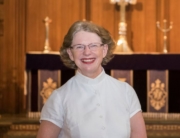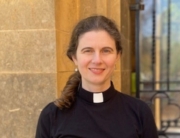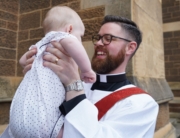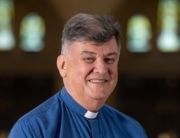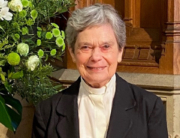ARE WE MORE LIKE MARY MAGDALENE OR THE RICH YOUNG LAWYER?
Each Easter, at 6am a very moving service takes place in our Cathedral. The Dean will light a candle from a brazier set up inside the West door. Then he will progress through the darkness towards the high altar and, on the way, first the clergy, then the acolytes, then the congregation and finally the choir will all have their candles lit by a spreading of the light – the ‘light of Christ’. That service never ceases to reverberate deeply within many of us as the moment of Christ is Risen is recalled.
Similar services are held in many churches of many denominations – similar in the sense of celebrating the coming of the light of Christ. However, there can be differences in the staging, if I may cautiously use that word.
I have, over the years, often attended the midnight Easter service in Greek Orthodox churches. In their services, at the stroke of midnight the priest retreats behind the Royal Door that is in the reredos separating the congregation from the high altar. Like our cathedral, the church is in total darkness. Then the Royal Door slides open revealing the priest standing there holding three lit candles tied together as a symbol of the Trinity. There will then be a progressive sharing of the light throughout the whole congregation. But it is in some of the Greek Orthodox services that I have noticed a key difference to the way that sharing takes place.
The first time I attended such a service, the symbolism of what happened stirred deep within me. For, before the Royal Door slid open, many women from the congregation had started to leave the pews and moved quietly towards the still closed door. By the time the Royal Door opened revealing the trinity of lit candles, there were many women crowding in front of the entrance. Each of them eager for her candle to be amongst the first lit. And as they were lit, those women would then light the candles of other women behind them. Then, returning to the pews, all the women would share the light with those still sitting there, men and women. And so, with the light growing within the church, the symbol of ‘the light of Christ’ played out.
Later, when I have again attended Orthodox Easter Day services, I have sometimes been disappointed to see some men amongst the throng gathered expectantly at the Royal Door. That first time I had witnessed this service, it had seemed to me so appropriate that it had only been women waiting for the door to be slid open; for, according to the gospels, it was women who were first at the open tomb on Easter Day.
Today is the Sunday when we commemorate Mary Magdalene. She is mentioned twelve times in the four canonical gospels, which is more than most of the apostles. Her first appearance in the gospels deals with her being freed from seven demons. Luke 8: 1-3 relates the episode:
Soon afterwards he went on through cities and villages, proclaiming and bringing the good news of the kingdom of God. The twelve were with him, as well as some women who had been cured of evil spirits and infirmities: Mary, called Magdalene, from whom seven demons had gone out, and Joanna, the wife of Herod‘s steward Chuza, and Susanna, and many others, who provided for them out of their resources.
From the moment of her being freed from mental distress, Mary of the town of Magdala, walked away from her former life and followed Jesus. The remainder of the references to her in the gospels, however, relate to her presence both at the crucifixion and afterwards at the resurrection. Recall two of the references from tonight’s gospel reading. At the crucifixion we have chapter 15:40-41:
There were also women looking on from a distance, among them were Mary Magdalene, and Mary the mother of James the younger and of Joses, and Salome. These used to follow him and provided for him when he was in Galilee; and there were many other women who had come up with him to Jerusalem.
Then, at the Resurrection, chapter 16, verses 1 and 2 we read:
When the sabbath was over, Mary Magdalene, and Mary the mother of James, and Salome, bought spices, so that they might go and anoint him. And very early on the first day of the week they went to the tomb when the sun had risen.
Mark’s recording of these events corroborates what was recorded in the other three canonical gospels. John’s gospel mentioned Mary Magdalene amongst others standing at the cross, though didn’t mention the ‘many other women’ mentioned by Mark. Luke didn’t mention any women being at the foot of the cross at all, though did mention that Jesus addressed the ‘large number of people (that) followed him, including women’ (Luke 23:27) as he was led away to be crucified. Luke further noted that, in addressing this crowd, Jesus spoke only t the women among them:
Daughters of Jerusalem, do not weep for me. {v28]
Matthew’s gospel also mentioned that ‘many women were there (though they were) watching from a distance’[27:55] before going on to name the same women named by Mark. After the crucifixion, Mary Magdalene and ‘the other Mary’ were reported by Matthew to have been present that Easter dawn. Like Mark, Matthew’s gospel had the angel telling the women:
But go, tell his disciples.
And in these five words, we have a message that affirms the historic truth of the gospel account of the resurrection. How so?
Who was there at the entrance to the empty tomb? Women. Who did the angel tell to go and witness to the other disciples? Women. With our twenty-first century mindset and social context, we may very easily miss the significance of what had happened that Easter day in society very different from our own.
If the gospel writers, writing some decades after the event, had wanted to massage the story to be acceptable to first century listeners, they would have airbrushed the women out of the scene, replacing them with male witnesses. For in the Judaic culture of the time, women could not be witnesses. Deuteronomy 19:15-17 contained specific reference to the role of witnesses but the key, according to Talmudic scholars over time, was the Hebrew word used – עֵדִ֖ים [edhim] – it was masculine in gender and, scholars averred, this meant that only males could testify. Interestingly, it was not until 1951, with the passage of the Equality of Women’s Rights Act by the Israeli Knesset, that the testimony of women would be accepted in Jewish courts; though, even to this day, some conservative Jews still adhere to the old Talmudic interpretations.
One might imagine first century editors receiving the manuscripts from the gospel writers and being shocked to see women reported as the first testifiers. They would have been aghast – ‘couldn’t you just bring some men into the picture, and name them? – you could then drop the names of the women just like you didn’t mention them in your text about the miracle of the loaves and fishes.’ But this the gospel writers couldn’t do, because that was not what had happened. It was women who were the first witnesses, not men and so the story would have to be true to that fact. And it is that holding to a social fact which would have been socially unacceptable at the time that tells us these writers were not spin-doctoring about what had happened that fateful weekend. They did not relate ‘fake news’, they wrote what they had been told had actually taken place … women were the first there and that was what they saw and heard – an empty tomb and an angel speaking to them.
In all the gospel reports of that day at the tomb, Mary Magdalene was the first named amongst the women mentioned. Clearly she was being acknowledged as a significant person of the time. Modern scholarship suggests that she was a wealthy woman. Indeed, the second verse of our reading tonight indicates that she, along with the other Mary and Salome, were of sufficient independent means that they could care for Jesus. Similarly, contemporary opinion is that historically Mary Magdalene has been unfairly described as a former prostitute; blaming that on a Western church tradition to conflate Mary Magdalene with the sinful women spoken of in Luke 7:36-39; a tradition, interestingly, not shared by the Eastern Orthodox church.
Indeed, the Orthodox church has always regarded Mary Magdalene as an equal of the apostles and one of the eight myrrh-bearing women who, in its tradition, share the second Sunday after Easter as a day to acknowledge that it was women who had brought this expensive spice used not just for burials but, equally significantly, for anointing of the tabernacle (as we read in Exodus 30:23-25). In bringing myrrh to the empty tomb, Mary Magdalene, along with the other Mary and Salome, had come to use myrrh as a burial spice, but in the event, unexpectedly had taken part in an anointing of Jesus as the temple – the temple that, by his resurrection, Jesus was raising up again.
Apart from the references to Mary Magdalene at the crucifixion and the resurrection, and putting aside the now disregarded associations of her being the same as the sinful woman of Luke 7 or even as Mary of Bethany [Luke 10:38-42], the only other reference to her in the gospels is the one I mentioned before – Luke 8:2-3 – where we read of her being ‘cured of evil spirits’; and also that she was one of the women helping support Jesus from ‘out of their own means.’ It is unlikely that Jesus would have wanted to live off ill-gotten proceeds from Mary Magdalene; so we may assume that her wealth had been respectably earned.
At this point let us compare Mary Magdalene with the rich young lawyer reported in Matthew 19:16-22. That young man had come to Jesus asking “Teacher, what good thing must I do to get eternal life?” When Jesus answered him by citing key commandments, the young man had responded: ‘All these I have kept … what do I still lack?’ Jesus then added that maybe the young man would consider selling all that he had and following Jesus. This had been too much for him and he had gone away sad.
How different from Mary Magdalene. She had come to Jesus not at all certain of herself – indeed her life was a mental and emotional turmoil, described by Luke as seven evil spirits. She was wealthy but it had not made her happy; compare this with the wealthy young man who wanted the next star of happiness – eternal life – to complement that which he had already achieved. He had seen Jesus and been impressed much like the Helga bread advertisement – “I’ll have what he’s having”. But in asking that, he could see nothing profoundly missing in his own life. He was like those who say, ‘But I live a good life, a life according to Christian values.’
The reference to Mary Magdalene’s seven evil spirits would seem to be a metaphor for commandments that she had failed to obey. And so she had not, as the young lawyer had done, gone to Jesus in an assurance of her own self-perceived goodness, she had gone to him in her acknowledged failings – failings which tormented her. Jesus had then spoken to her, so she had followed him. And she would follow him to the very cross itself and beyond.
There is a clear message to each of us here. How do we come before Jesus? With a sense of certainty about ourselves, expecting Jesus to say to us “Well done, thou true and faithful servant”, confident that we believe we have led good lives? Or will we come, in the way of the Jesus prayer so often used by Orthodox Christians – “Jesus, son of God, have mercy on me a sinner”? In other words, will we be like Mary Magdalene rather than the young lawyer.
So today is the Sunday that each year we remember Mary Magdalene. Over the centuries, her name has become commonplace and her reputation often worse than common. Yet, if we reflect upon how she was portrayed in the gospels and upon how the male disciples were treated with, we might share with the poet Eaton Stannard Barrett who, in 1810, wrote this of Mary Magdalene:
Not she with trait’rous kiss her Saviour stung,
Not she denied Him with unholy tongue;
She, while apostles shrank, could danger brave,
Last at His cross, and earliest at His grave.
Eaton Stannard Barrett, Woman (1810), Part I, lines 141–145
Mary Magdalene was a woman of singular self-awareness and courage who was not found wanting when, in her time, our ever so mortal world encountered eternity at the crucifixion and the resurrection. Of course, in our time, we cannot be at the foot of the cross, that moment has gone in history, but we can still be at the empty tomb every moment of our lives, saying to ourselves:
He is raised, He is not here … he goes ahead of us (and) there (we) will see him.
Then, from our weakness, we can go and tell the others about ‘the light of Christ’.

